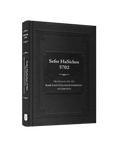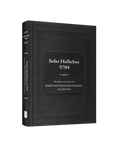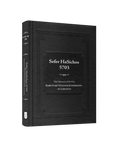A Call to Action Amidst the Inferno
Sefer HaSichos 5703: The Sichos of (5703: 1942-1943)Talks delivered in 5703 (1942-1943) by Rabbi Yosef Yitzchak Schneersohn, the Sixth Lubavitcher Rebbe
Imagine the excitement of being invited to the Yom-Tov table of the Rebbe Rayatz on Shavuos, in 1943!
In the absence of video or tape recordings, the nearest you can get to that privilege today is to relish the refreshing scoop with which the newly-released Sefer HaSichos 5703 opens – a facsimile of the never-before-published original manuscript of the first page of the notes which one of the participants later made from memory of that farbrengen. That facsimile is seasoned with corrections and annotations that were liberally inserted in the unmistakable handwriting of the Rebbe, who at the time was seated next to the Rebbe Rayatz.
Other highlights in this volume include the empowering response of the Rebbe Rayatz to the events of his time, at the peak of the Holocaust. Not that he endeavors to avert his gaze from the harsh reality of that era. On the contrary: “One’s head is dulled, one’s heart is bruised, one’s spirit is battered.” His response, however, is a bold call to arms, an impassioned plea to his chassidim to go out and challenge their brothers and sisters to ease the birth pangs of Mashiach by resisting the tsunami of assimilation that threatened their very survival as Jews, in the Land of the Free.
In a move that pioneered the outreach and the mivtza’im of our generation, he urged Anash to simply knock on door after door. Their task was to persuade the migrants around them to pause a moment from the local rat-race in pursuit of the golden dollar, and to salvage whatever they recalled of the time-honored values of the Old Country by enrolling their children in kosher Talmud Torah schools.
One of the widely-respected bodies that the Rebbe Rayatz criticized outspokenly in this volume was Youth Aliyah, the project by which a thousand Polish-born refugee children, many of them orphans, were rescued by self-sacrificing fellow Jews and brought to the Holy Land via India and Teheran, but were then educated in institutions whose spirit was utterly alien to the observant homes in which they had been raised. And as to the faithless and unobservant rabbis who taught in America’s after-school Talmud Torah schools, he declared outspokenly that “the fact that the prominent members of the Agudas HaRabbonim (the roof organization of Orthodox rabbis) stand aside coolly in the face of this situation is utterly incomprehensible.”
At the same time, like its five predecessors, this volume too sparkles with scores of heartwarming moments – unforgettable anecdotes, chassidic folk history, good-humored galleries of colorful and inspiring personalities, a fascinating description of the stages by which his father, the Rebbe Rashab, groomed his young son for the historic life-work that awaited him, and of course a wealth of Torah teachings. Apart from those that are original and appear here for the first time in translation, many are teachings that the Rebbe Rayatz faithfully transmitted from his illustrious forebears. (In fact, he once described himself as “a funnel!”)
This volume, too, was prepared by Sichos In English for publication by Kehot Publication Society and sponsored by Yossi Malamud, and its English translation by Uri Kaploun captures much of the informal Old World charm that Yiddish-speakers relish.























